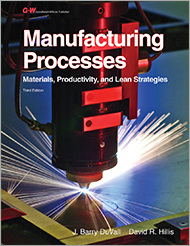Manufacturing Processes, 3rd Edition
By: J. Barry Duvall and David R. HillisCopyright: 2012
Subject: Manufacturing / Metals
Grade Level: 13-14
- Manufacturing Processes provides an in-depth introduction to the manufacturing processes found in existing and developing industrial facilities. An overview of current automated manufacturing systems is presented. The five major materials are covered: metals, plastics, ceramics, woods, and composites. This text provides a thorough coverage of the forming, separating, fabricating, conditioning, and finishing processes related to each material. A chapter covering packaging completes the text.
- Products & Prices College & Career
- Table of Contents
- Section 1: Manufacturing Today1. Introduction to Manufacturing
2. Material and Process ClassificationsSection 2: Cost-Saving Approaches3. Planning for Production
4. Identifying Opportunities for Improving Manufacturing ProcessesSection 3: The Decision to Automate5. When to Consider Automation
6. Automated Manufacturing Systems
7. Sensors and Devices for AutomationSection 4: Selecting Appropriate Materials8. Behavior and Characteristics of Manufacturing Materials
9. Characteristics of Metallic Materials
10. Characteristics of Plastic Materials
11. Characteristics of Wood Materials
12. Characteristics of Ceramic Materials
13. Characteristics of Composite MaterialsSection 5: Manufacturing Process Database14. Processes Used to Form Metallic Materials
15. Processes Used to Form Plastic Materials
16. Processes Used to Form Wood Materials
17. Processes Used to Form Ceramic Materials
18. Processes Used to Form Composite
19. Processes Used to Separate Metallic Materials
20. Processes Used to Separate Plastic Materials
21. Processes Used to Separate Wood Materials
22. Processes Used to Separate Ceramic Materials
23. Processes Used to Separate Composite Materials
24. Processes Used to Fabricate Metallic Materials
25. Processes Used to Fabricate Plastic Materials
26. Processes Used to Fabricate Wood Materials
27. Processes Used to Fabricate Ceramic Materials
28. Processes Used to Fabricate Composite Materials
29. Processes Used to Condition Metallic Materials
30. Processes Used to Condition Plastic Materials
31. Processes Used to Condition Wood Materials
32. Processes Used to Condition Ceramic Materials
33. Processes Used to Condition Composite Materials
34. Processes Used to Finish Metallic Materials
35. Processes Used to Finish Plastic Materials
36. Processes Used to Finish Wood Materials
37. Processes Used to Finish Ceramic Materials
38. Processes Used to Finish Composite MaterialsSection 6: Packing Products for Distribution39. Types of Packaging - The Look Inside images are for preview purposes only. The format of the actual product may vary from the images shown.
- About the Author(s)


